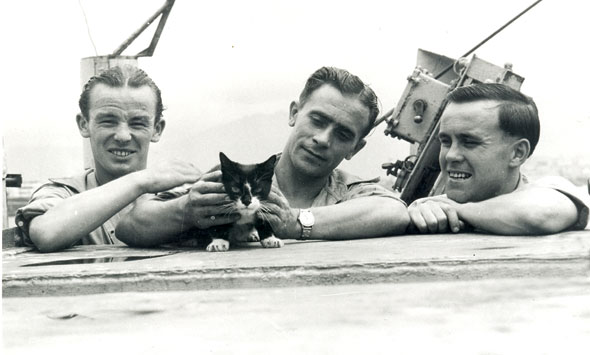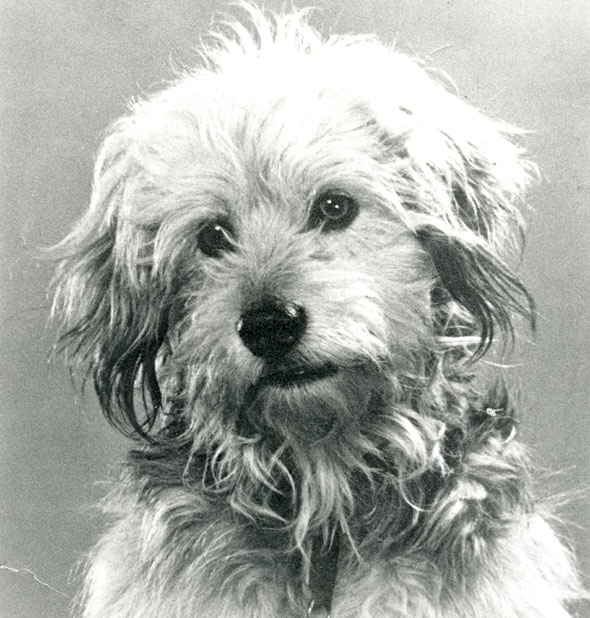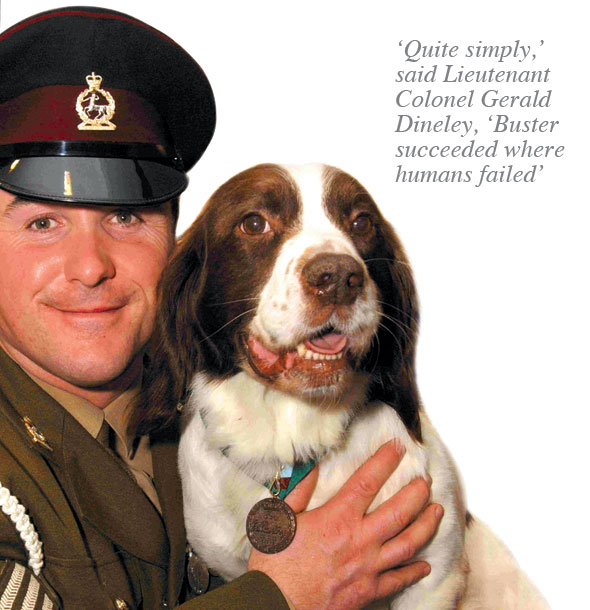THE PIGEON HERO OF D-DAY
This year, Army dog Theo was awarded the medal posthumously for life-saving bravery in Afghanistan, uncovering bombs. When his handler Lance Corporal Liam Tasker was tragically shot dead in action, Theo passed away a few hours later, many say as a result of a broken heart.
Since its inception in 1943, 28 dogs, 32 messenger pigeons, three horses and one cat have been awarded the medal. Here are just a few of their stories…
PADDY: Pigeon Date of award: 1 September 1944 (pictured above)
In September 2009, the BBC reported that ‘one of World War II’s smallest war heroes’ was to be honoured with afl y-past. The hero was Paddy, a messenger pigeon who took part in the D-Day landings while on secondment from the Royal Air Force to the US First Army. The flypast was performed by a flock of pigeons released over a new memorial to this very singular bird, close to his former home in Northern Ireland.
‘An Irish pigeon trained in England by a Scotsman with a Welsh assistant’, Paddy was raised by Captain Andrew Hughes in Carnlough, County Antrim, 70 years ago.
Before being sent with thousands of birds to RAF Hurn in Hampshire, he was given the number NPS 43. 9451 and assigned to the air-sea rescue unit at RAF Ballykelly.
Paddy soon attracted the attention of the authorities, being described by one handler as of ‘exceptional intelligence’. This led to him being attached to the US military, which intended using a number of British-trained birds for D-Day missions. The birds were considered more secure than radio communications, but faced German- trained falcons along with the other terrors of warfare.
According to the late John McMullan, a veteran pigeon fancier who helped Captain Hughes train many of his birds back in Ireland, Paddy was ‘the last pigeon to be let go by the Americans in Normandy and he was the first one home. He was the best of the lot, the best of thousands.’
Crucially, his message was also the first to indicate the probable success of Operation Overlord.
Paddy beat hundreds of similar birds back to England and did so by nearly half an hour.
Released at 08.15 on 12 June, Paddy’s performance was by any standards impressive. He covered 230 miles in just 4 hours 50 minutes, an average speed of nearly 50mph – arriving in his loft near Bournemouth with valuable intelligence about the Allied progress in the long-awaited invasion of the German Reich.
A year later, after being demobbed, Paddy was returned to Carnlough and Captain Hughes, who looked after him until the bird’s death in 1954.
Something of an unlikely local hero, but deservedly so, as the only Irish PDSA Dickin Medal recipient, Paddy’s legend was to live on. In 2003 he became the star of a children’s book, Paddy The Pigeon.
‘Able Seaman’ Simon: Cat Date of award: 11 December 1949 (posthumous)

An undernourished black-and-white tom picked for a ship’s cat from the docks of Hong Kong’s Stonecutter Island, Simon joined HMS Amethyst in 1948 when it passed through the Crown colony en route from Malaya.
The stray was smuggled aboard by Ordinary Seaman George Hickinbottom, a 17-year-old crew member fortunate enough to have a cat lover for a captain, who recognised the threat rats posed on a ship. Simon was quick to make himself useful and took great pride in laying out his victims. Occasionally these gory trophies would be left in the seamen’s bunks, and when he could get away with it, Simon slept curled up in the captain’s cap.
In the spring of 1949, Amethyst was ordered up the Yangtze River to Nanking. Its mission was to replace HMS Consort, which was serving as a guard ship for the British embassy during the civil war fought between China’s communist People’s Liberation Army (PLA) and the Kuomintang Chinese Nationalists.
But on 20 April 1949, in what became known as the Yangtze Incident, the vessel came under heavy fire from a PLA battery. One volley tore through the bridge, fatally wounding the captain. With 17 crew dead or dying, Simon was among the casualties and was found in the wreckage with shrapnel wounds to his legs and back. He is assumed to have been sleeping in the captain’s cabin when a shell ripped a 15-foot hole through the adjacent bulkhead.
Clearly patching up a cat was on no one's list of d-day no one’s list of priorities, although with stores running low – and rats breeding fast in the humid atmosphere – Simon’s hunting skills were needed more than ever. Despite his severe injuries, he rose magnificently to the challenge, and he was soon exceeding his normal peacetime tally of kills – although it was noted that his whiskers had grown back bent.
After responding to an order from George VI in London for the crew to splice the mainbrace, Able Seaman Simon was awarded the Amethyst campaign ribbon at the China Fleet Club. The following citation was read out: ‘Able Seaman Simon, for distinguished and meritorious service on HMS Amethyst, you are hereby awarded the Distinguished Ame-thyst Campaign Ribbon. Be it known that on 26 April, 1949, though recovering from wounds, when HMS Amethyst was standing by off Rose Bay, you did single-handedly and unarmed, stalk down and destroy “Mao Tse Tung”, a rat guilty of raiding food supplies which were critically short. Be it further known that from 22 April to 4 August you did rid HMS Amethyst of pestilence and vermin, with unrelenting faithfulness.’
When the crew made it back they were met by Prime Minister Clement Attlee, and the date for Simon’s presentation was set for 11 December 1949 in the presence of both Maria Dickin and the Lord Mayor of London. But sadly it was never to be. Required like any ordinary cat to spend several months in quarantine, Simon became listless a couple of weeks ahead of the ceremony and died on the night of 27 November. He was still only a young cat, but his injuries had left him unable to fight off a virus.
When the news of his death broke, the quarantine centre in Surrey was inundated with letters, cards and flowers, and the distress of the crew was plain to see…
Today there is a memorial plaque to Simon at the PDSA PetAid hospital in Plymouth.
Ricky: Long-haired sheepdog puppy Date of award: 29 March 1947

Ricky was volunteered for war service in 1944 by his owner. Mrs Litchfield of Bromley in Kent had bought the puppy for seven shillings and sixpence earlier that year. On leaving training school, Ricky was assigned to 279th Field Company of the 15th (Scottish) Infantry Division and put into the care of Maurice Yelding, who had been a circus artiste before being called up.
The division had seen heavy action during the First World War and by the 1940s it had been recast as a second-line Territorial Army division, engaged in Normandy as part of the D-Day landings and then three weeks later in Operations Epsom and Goodwood, which were bids to out-flank and capture strategically important positions in and around Caen.
December 1944 found Ricky and Private Yelding in the Netherlands, engaged in dangerous mine clearance. Since July of that year, four platoons of sappers had been posted to northwest Europe, their sniffer dogs working seven days a week along hundreds of miles of roads, water – and railways. Ricky was set to work along the Noordevaart, a canal in Nederweert.
What Yelding was later to describe as ‘the nearest escape’ took place on a freezing day while the two of them were working in tandem. The details of what happened were relayed to Mrs Litchfield by way of an extended quotation from an official dispatch concerning the operation.
‘The above-mentioned dog on 3 December 1944 was engaged in the task of clearing the verges of the canal bank at Nederweent [sic] Holland.’ He ‘found all the mines and during the operation the Section Commander was blown up. Ricky was wounded in the head but kept on working and remained calm… Had he become excited he would have been a danger to the rest of the Section nearby.’
Yelding confirmed this description of events in his letter to Mrs Litchfield, telling her that the events described were ‘no exaggeration. You notice it says “nearby”. We were within three feet of the mine and in the middle of a minefield. I am confident that [Ricky] was as steady as the Rock of Gibraltar and I think it was his coolness that brought us out of a sticky patch safely.’
Ricky worked alongside his comrades until the end of the war and might have stayed on had the authorities’ offer to buy him from Mrs Litchfield (who had only loaned him) been accepted. According to Dorothea St Hill Bourne, secretary of the Allied Forces Mascot Club at the time, the offer was made of ‘the maximum amount allowed for a dog’ – the Army being keen to retain a dog with such a record of steadfastness – but his owner was not to be persuaded. Instead it was arranged for Ricky to travel home to Kent, Yelding in the meantime writing to assure Mrs Litchfield that ‘I have still got him and as long as I am here I will look after him. I owe him that.’
Nothing, he said, would make him happier than to see the dog he called Rag-Bag safely on the boat home and rejoining his family.
In late 1946 he was recommended for the PDSA Dickin Medal, and in March the following year one was presented to the brave dog who had cost his owner the equivalent of 37.5p.
Buster: Springer spaniel – Royal Veterinary Corps arms and explosives search dog Date of award: 9 December 2003

Buster, a five-year-old gun dog found in a rescue home, was credited with saving lives during the Iraq War. The particular action referenced in Buster’s medal citation took place in the town of Safwan on the Kuwaiti border. It followed an early-morning raid on what was thought to be a Ba’athist stronghold by about 200 Nato troops.
When the objective had been secured, as many as 16 supporters of Saddam Hussein were arrested, but nothing was found in the way of weapons or explosives. The Iraqis insisted that they had nothing to hide, but Buster and his handler, RAVC Sergeant Danny Morgan, then aged 37, were detailed to have a closer look around.
In such circumstances it is standard practice to allow the dog to enter a suspect building first in case the area is booby-trapped. Buster went in and, according to Sergeant Morgan, immediately ‘became excited in a particular area, and I knew he’d discovered something’. In fact the dog had stumbled upon a cache of weapons, carefully concealed.
Lieutenant Colonel Gerald Dineley of the Army Medical Directorate was most enthusiastic about the dog’s performance. ‘Quite simply,’ he said when the medal award was first announced, ‘Buster succeeded where humans failed.’
As a result of the removal from use of a potentially deadly stock of weapons, attacks on Allied troops in the surrounding area ceased at once. It was a turning point, so that soldiers on the ground were able to replace their protective steel helmets with berets. Returning from Safwan to Hampshire after the war, for a while he lived as a family pet with Morgan, his wife Nicki and their five-year-old daughter Emma.
Extract from The Animals’ VC: For Gallantry Or Devotion, by David Long, published by Preface, priced £14.99.
For more information on the PDSA: www.pdsa.org.uk


